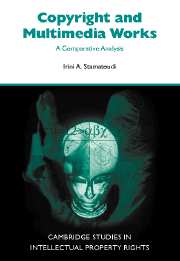Book contents
- Frontmatter
- Contents
- Acknowledgments
- List of abbreviations
- Introduction
- 1 Placing multimedia products within the scope of copyright
- 2 The scope of multimedia works
- 3 Traditional literary works
- 4 Collections and compilations
- 5 Databases
- 6 Audiovisual works
- 7 Computer programs
- 8 Video games as a test case
- 9 Multimedia products and existing categories of copyright works
- 10 A regime of protection for multimedia products
- 11 Conclusions
- Postscript
- Bibliography
- Index
7 - Computer programs
Published online by Cambridge University Press: 25 July 2009
- Frontmatter
- Contents
- Acknowledgments
- List of abbreviations
- Introduction
- 1 Placing multimedia products within the scope of copyright
- 2 The scope of multimedia works
- 3 Traditional literary works
- 4 Collections and compilations
- 5 Databases
- 6 Audiovisual works
- 7 Computer programs
- 8 Video games as a test case
- 9 Multimedia products and existing categories of copyright works
- 10 A regime of protection for multimedia products
- 11 Conclusions
- Postscript
- Bibliography
- Index
Summary
A MULTIMEDIA WORK AS A COMPUTER PROGRAM
A multimedia product cannot perform its tasks unless it is assisted by a computer program. It is the computer program which produces the interactive effects and allows the user to retrieve and arrange the contents of the multimedia work on his screen. The multimedia work and the computer program are marketed as one product. Both are developed in a digital environment and distributed on a digitised medium or as a digitised service. The facts that both multimedia works and computer programs operate in a digitised environment, that the presence of the computer program is indispensable to the functioning of a multimedia work and that the architecture of a multimedia work relies on the design of its computer program have urged many to think that we should investigate the possibility of whether a multimedia work can be protected as a computer program.
Any attempt to protect a multimedia product as a computer program can only be based on certain grounds. It can be based either on the fact that in essence a multimedia work is nothing more than a computer program, or alternatively on the fact that if a multimedia work is more than just a computer program, this ‘more’ is only subordinate to a computer program and not substantial enough to warrant differential treatment. What is involved in the first case could simply be called a sophisticated computer program.
- Type
- Chapter
- Information
- Copyright and Multimedia ProductsA Comparative Analysis, pp. 152 - 165Publisher: Cambridge University PressPrint publication year: 2001



